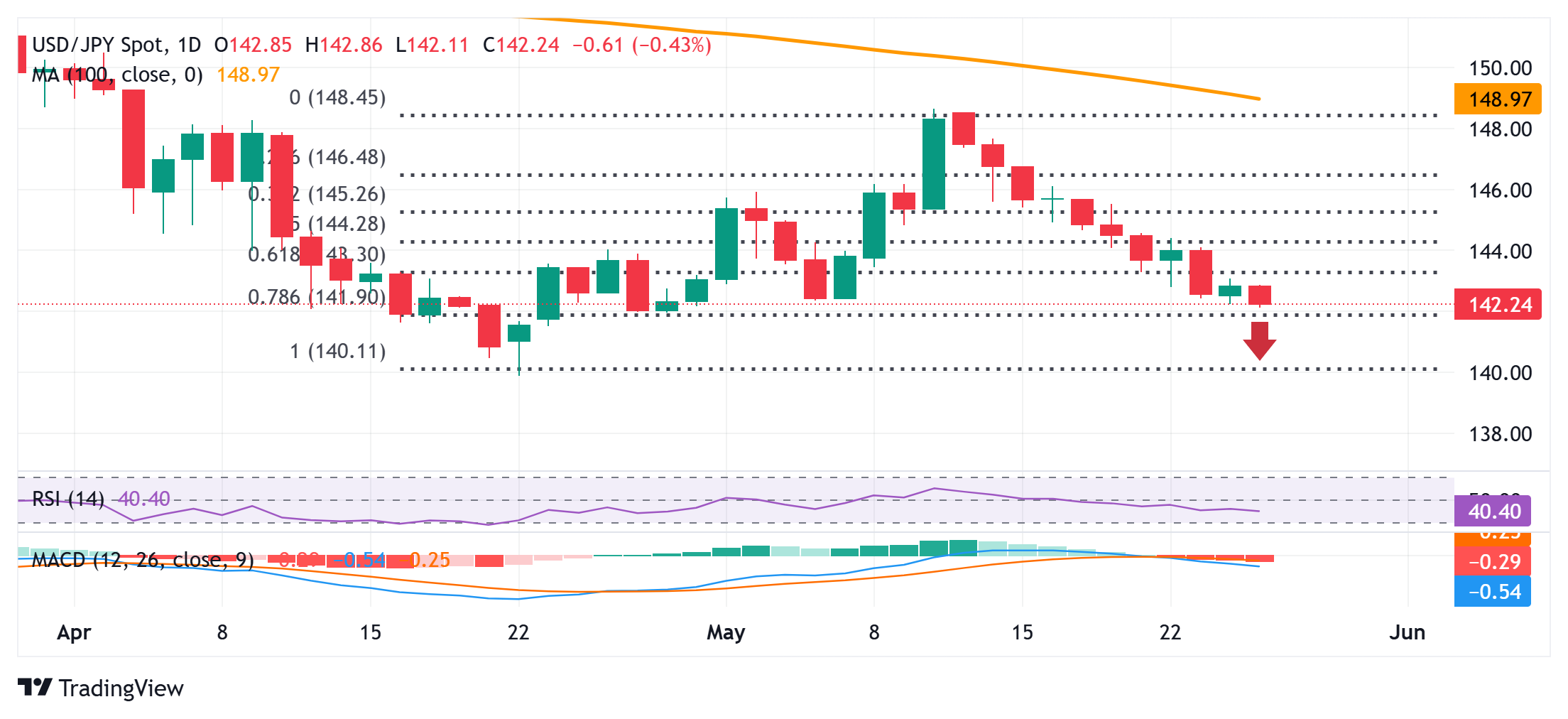- The Japanese Yen catches fresh bids in reaction to Japan’s strong Services PPI.
- The data reaffirms BoJ rate hike bets and boosts the JPY amid geopolitical risks.
- Dovish Fed expectations undermine the USD and exert pressure on USD/JPY.
The Japanese Yen (JPY) attracts fresh buyers during the Asian session on Tuesday following the release of strong inflation data. Adding to this, Bank of Japan (BoJ) Governor Kazuo Ueda’s comments left the door open for further policy tightening by the central bank. This marks a sharp divergence in comparison to expectations that the Federal Reserve (Fed) will cut interest rates further this year and turns out to be a key factor that provides a goodish lift to the JPY.
Apart from this, persistent geopolitical risks stemming from the protracted Russia-Ukraine war and conflicts in the Middle East further benefit the JPY’s relative safe-haven status. The US Dollar (USD), on the other hand, remains depressed near its lowest level since April 22 amid concerns about the worsening US fiscal situation. This contributes to the USD/JPY pair’s slide to the 142.00 neighborhood, or over a one-month low, and supports prospects for further losses.
Japanese Yen gets a strong lift as stronger domestic inflation data reaffirms BoJ rate hike bets
- The Bank of Japan reported earlier this Tuesday that the Services Producer Price Index (PPI) – a leading indicator of Japan’s service-sector inflation – rose 3.1% from a year earlier in April. This comes on top of last week’s strong consumer inflation figures and keeps alive expectations of further interest rate hikes by the Bank of Japan.
- Moreover, BoJ Governor Kazuo Ueda showed readiness to continue raising rates and said that the central bank must be vigilant to the risk rising food prices could push up underlying inflation that is already near its 2% target. This provides a goodish lift to the Japanese Yen and drags the USD/JPY pair to over a one-month trough.
- Japan’s Finance Minister Katsunobu Kato said that interest rates reflect various factors, but the market sees rising rates as reflecting concerns about state finances. Kato added that the government will closely monitor the bond market situation amid rising super-long bond yields and will continue close dialogue with bond investors.
- US President Donald Trump announced an extension of the deadline for imposing 50% tariffs on European Union imports to July 9, lifting the global risk sentiment. However, the uncertainty around Trump’s trade policies remains, which keeps investors on edge and turns out to be another factor benefiting the JPY’s safe-haven status.
- Trump called Russian President Vladimir Putin ‘crazy’ and said that he was considering new sanctions against Russia after the biggest drone attack on Ukraine in the more than three-year-old war. Furthermore, Israel continues to pound Gaza, keeping geopolitical risks in play and further underpinning demand for the JPY.
- The US Dollar, on the other hand, struggles to attract any buyers and languishes near the monthly trough amid worries that Trump’s sweeping tax cuts and spending bill would worsen the US budget deficit. This, along with dovish Federal Reserve expectations, exerts additional pressure on the buck and the USD/JPY pair.
- Traders now look forward to the US economic docket – featuring the release of Durable Goods Orders and the Conference Board’s Consumer Confidence Index. The focus, however, will remain glued to the FOMC minutes, the Prelim US Q1 GDP print, and the US Personal Consumption Expenditure (PCE) Price Index.
- Investors this week will also confront the release of Tokyo CPI on Friday, which will play a key role in influencing the JPY price dynamics. Nevertheless, the fundamental backdrop seems tilted in favor of the JPY bulls and suggests that the path of least resistance for the USD/JPY pair remains to the downside.
USD/JPY bears now await a break below the 142.00 mark before positioning for further decline

From a technical perspective, the previous day’s failure ahead of the 61.8% Fibonacci retracement level of the April-May rally and the subsequent slide favors the USD/JPY bears. Moreover, oscillators on the daily chart are holding in negative territory and are still far away from being in the oversold zone. This, in turn, supports prospects for a further near-term depreciating move for the currency pair. Some follow-through selling below the 142.00 mark will reaffirm the outlook and drag spot prices below the 141.55 intermediate support, towards the 141.00 round figure. The downward trajectory could extend further towards the year-to-date low, or levels below the 140.00 psychological mark touched on April 22.
On the flip side, any attempted recovery might now face stiff resistance near the 143.00 round figure. This is closely followed by the 143.25 area, or the 61.8% Fibo. retracement level, which if cleared decisively could trigger a fresh bout of a short-covering and lift the USD/JPY pair to the 143.65 region en route to the 144.00 mark. A sustained strength beyond the latter could pave the way for further recovery, though the move up might still be seen as a selling opportunity near the 144.80 zone and remain capped near the 145.00 psychological mark.
Bank of Japan FAQs
The Bank of Japan (BoJ) is the Japanese central bank, which sets monetary policy in the country. Its mandate is to issue banknotes and carry out currency and monetary control to ensure price stability, which means an inflation target of around 2%.
The Bank of Japan embarked in an ultra-loose monetary policy in 2013 in order to stimulate the economy and fuel inflation amid a low-inflationary environment. The bank’s policy is based on Quantitative and Qualitative Easing (QQE), or printing notes to buy assets such as government or corporate bonds to provide liquidity. In 2016, the bank doubled down on its strategy and further loosened policy by first introducing negative interest rates and then directly controlling the yield of its 10-year government bonds. In March 2024, the BoJ lifted interest rates, effectively retreating from the ultra-loose monetary policy stance.
The Bank’s massive stimulus caused the Yen to depreciate against its main currency peers. This process exacerbated in 2022 and 2023 due to an increasing policy divergence between the Bank of Japan and other main central banks, which opted to increase interest rates sharply to fight decades-high levels of inflation. The BoJ’s policy led to a widening differential with other currencies, dragging down the value of the Yen. This trend partly reversed in 2024, when the BoJ decided to abandon its ultra-loose policy stance.
A weaker Yen and the spike in global energy prices led to an increase in Japanese inflation, which exceeded the BoJ’s 2% target. The prospect of rising salaries in the country – a key element fuelling inflation – also contributed to the move.

